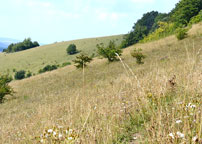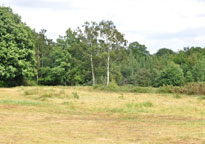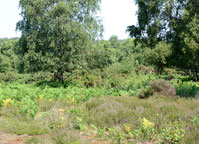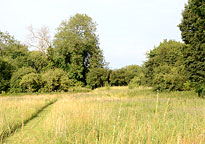Some thoughts on grassland management for Butterflies, long grass is not always bad.
Some Butterflies are dependent on shrubs and trees as larval food plants. The larval food plants for the others are herbaceous plants, some such as Garlic Mustard, Honeysuckle and various Violets growing in lightly shaded woodland and their margins but most herbaceous food plants grow out in the open more or less surrounded by grasses - that is to say in grassland. Sooner or later unmanaged grassland in this country usually becomes swamped out by a natural succession of small shrubs and then trees and the low level larval food plants die out. On more fertile soils unmanaged grass can build up a thick straw-like layer of dead grass at soil level, changing the species-mix of the grassland. This can take several seasons and does not have to be removed every year.
Ignoring the 'green concrete' of amenity grassland and lawns where flowering plants are regularly killed off in the persuit of neatness, and farming leys (short term grass crops from seed), that leaves permanent pasture managed for grazing and hay, roadsides and sites managed for wild life.
BRIEFLY, there are two main grassland management systems:
1. Grass cut or grazed to protect low growing plants from being swamped by taller grasses, nettles etc. (includes hay meadows).
Advantages: this is good for low growing larval food plants, especially those on poor chalky soils, and for many other spring and early summer flowers.
Disadvantages: this removes tall, late summer nectar flowers on fertile soils. It kills any the eggs, larvae and pupae of any butterflies present (Skippers in grass, Peacocks etc on nettles)
above the level of the cut at the time.
2. Seldom cut/grazed grass (except where necessary to remove scrub).
Advantages: this leaves tall plants to provide nectar though late summer. This is good for the butterflies whose eggs, larvae and pupae would
have been killed by cutting the grass and any taller legumes such as Field Pea also present.
Disadvantages: in some places low growing plants may be swamped out by the long grass and some desirable grasses can be gradually excluded by a thick straw-like layer of dead grass at soil
level. See Roseland House paddock.
Choice of system:
Some sites are more suited to one system than to the other.On poor calcareous soils a cut or grazed regime is the natural choice to protect the low growing native wildflowers including several essential butterfly foodplants including Horseshoe and Kidney Vetches, Rockrose and Sheep's Fescue. On other poor soils a summer 'hay' cut can encourage flowering plants, the removal of the 'arisings' helps by lowering the soil fertility which would otherwise encourage the lusher competing growth.
On poor sandy heathlands cutting with or without grazing is usually necessary to prevent scrub invasion. This is usually managed in a cycle, cutting a different portion each year. This allows old woody heathers to become refreshed with new growth, and restricts brambles and tree invasion. In some places chemical control has been successful against Bracken invasion.
On more fertile, non calcareus soils where the priority is not for spring flowers and calcareous specialists would not grow anyway, a case can be
made for less frequently cutting or grazing. This is not a very common habitat apart from strips of field and road margins, and provides a haven for the butterflies
dependent on the more robust grasses and associated plants. I have noticed in spring how much the ground layer of tussocky leftovers is used by Bumble Bees
as they commute to and from the nearby Sallow flowers. In its early years grassland converted from arable is less dense than ancient permanent pasture, and
sites next to woodland can initially produce a dense crop of tree seedlings.
A good compromise between killing butterflies as immature stages living in the grass (by cutting too often), and losing their favourite food plants (by not cutting enough)
would be to cut short enough to remove the basal thatch or to graze with cattle as and when necessary or at about once every four years in rotation one quarter at a time.
On more fertile, non calcareous soils where there is a particular priority for the more interesting spring flowering plants, such as Cowslips, Oxlips or Orchids cutting will be needed - as in hay meadows, and similarly removing the hay lowers soil fertility. A wider range of wildlife would be catered for by allowing a portion of the site to be permanently uncut.
What not to do. Cutting the grass once or twice a year when butterfly life cycle stages are at risk, and where there is no scrub invasion, depriving the butterflies of late nectar and the birds of seed.
Fine tuning areas of seldom cut grass.
Controlling trees and shrubs. Invasive growth from Blackthorn hedges and other scrub will need to be cut as and when it occurs. Tree seedlings such as Oak, and Alder can also be a problem, as well as overlarge patches of nettles.
Nettles are host plants for numerous insect species including several Butterflies - and some nettle patches are welcome in an area which is predominantly uncut grass. On reasonably fertile soils these patches expand slowly year by year and usually need some control. Spraying the edges with herbicide will slow them down a little, but a better solution is to mow paths round any nettle patches which are getting too big.
Introducing other food plants. Privet is one of the best plants to add for nectar. It produces masses of small white flowers in July at about mid-season for Meadow Browns and Ringlets, and is much favoured by bees. Sorrel has established here from seed, but most of the clover has been swamped out and I have not successfuly introduced Bird's Foot Trefoil. Taller legumes may do better in longer grass. Meadow Pea, Lathyrus pratensis is already present here and may be added to and a few other Vetches tried. In boggy areas Water Mint and Hemp Agrimony are excellent for nectar, and already present at Roseland House.
Introducing other nectar plants. Given the invasive habits of Thistles, Knapweeds may be a more suitable nectar plant for late summer pasture. The advantage of the Thistles is that
they flower in time for the main flight season of our most common species, and Knapweed comes into flower a few weeks later, covering the later part of the season.
Thistles are excellent nectar plants in long grass but they should not be allowed to spread to other property.
Preventing the spreading of weeds. Under the Weeds Act, 1959, the Minister has the power to require any particular occupier of land to prevent the spread of certain weeds. The Act applies to Spear Thistle, Creeping Thistle, Curled Dock, Broad-leaved Dock and Ragwort. The wind blown seeds of Thistles are most likely to be a problem. Here a topping cut in mid to late August as the flowers go over may be sufficient to prevent spreading by seed. A high topping cut would inflict minimal damage on any other wild life in the grass at that time.



